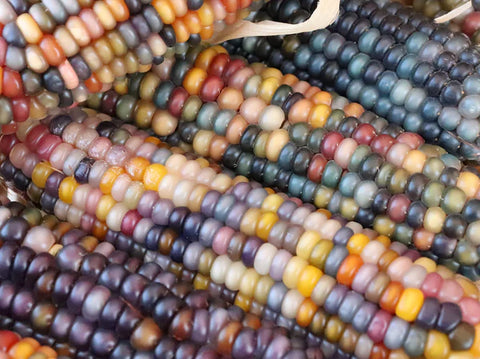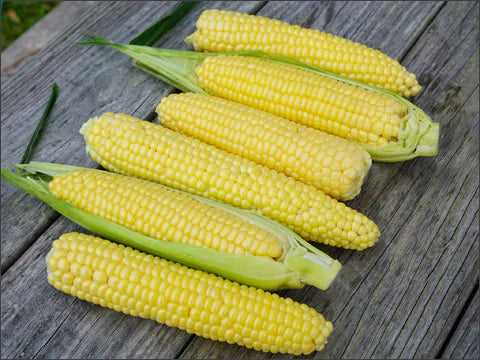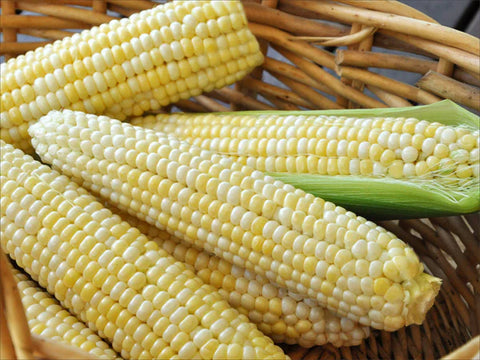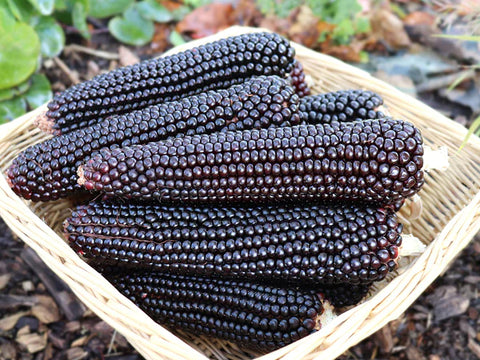Many Americans, when they think of growing corn, picture a yellow-kernelled cob with soft, green husks, or perhaps buttered and salted on a plate, freshly boiled, a side dish to a late-summer barbecue. But corn is so much more than that! In addition to sweet corn, there’s also popcorn, flint corn, dent corn, and flour corn. Corn comes in all colors of the rainbow! And while sweet corn tastes delicious fresh, varieties of dent and flint corn can be dried and used to make tortillas, hominy, porridges (like grits and polenta), and more.
Pictured: Glass Gem popcorn (click for seeds)
The Origins of Corn
Corn (Latin name Zea mays) originated in Central America as a wild inedible plant named teosinte. Indigenous people, over centuries, domesticated it and then migrated both north and south, taking the grains with them and painstakingly breeding it to be the incredibly diverse plant that we know and love today. Indigenous Mayan people took teosinte and, over the years, transformed it into nutritious, delicious, and beautiful corn. A truly a(maize)ing feat!
While the industrialization of hybrid dent corn (that is often highly processed and used to make ingredients found in a variety of junk “foods” or is used as animal feed to fatten cows and, in the process, also makes them sick) continues to be the dominant use of corn in the United States, corn is an incredibly diverse crop with rich and wide food traditions among indigenous people that should be celebrated and protected. Read on for more “corny” content.
Pictured: Top Hat Sweet Corn (click for seeds)
Why Grow Corn?
There are many reasons you should consider growing corn. To begin with, it’s relatively easy, as long as you have plenty of space to produce at least 16 plants - otherwise, you have to hand-pollinate it. Corn can also be very healthy when eaten fresh or unprocessed; it’s full of beneficial nutrients and vitamins. There are also many different varieties to try, and you’d be amazed at how many colors and types of corn exist beyond the common yellow corn you may be familiar with. Lastly, it’s incredibly versatile - you can eat it fresh, savory, or sweet, make popcorn, process it into flour, polenta, grits, hominy, use it as a decoration, and so much more!
Pictured: Soltera Morado Sweet Corn (click for seeds)
How To Grow Corn
Planting
Corn is wind-pollinated, so you should grow at least 16 corn plants (plant in a block – not in a row) so that enough pollen from the tassels will land on the silks to pollinate all kernels to produce full ears of corn.
To wind pollinate, follow these tips:
- Plant corn seeds after the soil has warmed to at least 65° (5/20-6/15).
- Plant seeds 6” apart in rows 36” apart (thin plants to 12” apart).
- Plant at least four rows of four plants in a block.
- Allow 3-12 days for germination.
- See variety instructions for the specific type of corn you are growing. All our varieties have detailed growing instructions on the product page on our website for your reference.
Not enough space for 16 plants?
- Hand-pollinate your corn to ensure full ears of corn
Planting Using the Three Sisters Method
The Three Sisters method, also known as companion planting, derives from the Native American tradition of planting corn, pole beans, and squash together in a mutually beneficial arrangement. To grow corn using this method, follow these tips
Plant corn, beans, and squash in “patches” that are 4 feet apart.
⏰ In each patch plant:
🌱 Soil
Corn is a heavy feeder, so plant in fertile, well-drained soil rich in organic matter and nutrients.
🔆 Light
Corn plants prefer bright sunlight and should be planted in areas with full sun when possible.
💧 Water
Corn is a high-demand moisture crop that will benefit from regular watering and needs an inch of water each week.
Maintenance & Troubleshooting
Corn is relatively easy to grow, but like any plant, it does need some maintenance to see the best results. Keep an eye out for these common issues:
Nitrogen deficiency: If you see older leaves turning yellow, your crop likely has a nitrogen deficiency. To prevent this from happening:
- Plant pole beans a couple of inches away from each corn stalk. Beans are nitrogen-fixers and may provide nitrogen to the corn.
- Plant your corn in rich soil with lots of organic matter - either make your own compost or buy some with good quality.
- Add nitrogen directly to the soil - we recommend Neptune’s Harvest or some other liquid fertilizer for the seedlings and for big plants that have already been planted in the field, using a dry, organic fertilizer that contains nitrogen. You can also use chicken manure, which is high in nitrogen.
- Plant your corn in rich soil with lots of organic matter - either make your own compost or buy some with good quality.
- Add phosphorus directly to the soil. We recommend Neptune’s Harvest or some other liquid fertilizer for the seedlings and for big plants that have already been planted in the field, using a dry, organic fertilizer that contains phosphorus. Check the bag label for phosphorus content.

How to Harvest Sweet Corn
Harvest corn when silks are brown and kernels have fully filled out but are still tender. Corn for Flour, Meal, Polenta, etc.:
- For flint, popcorn, and dent corn, you may wish to dry out the varieties once you’ve harvested.
- Once the tassels have browned and the husks have become brown and papery, harvest the corn.
- Carefully peel away the husk from the cob, ensuring it stays intact, as this will help with the drying process.
- You can then either place the cobs on a rack to dry or hang them. The goal is to get as much airflow as possible.
- Let them dry for at least a week or until you can press on the kernels and there is no denting that occurs.
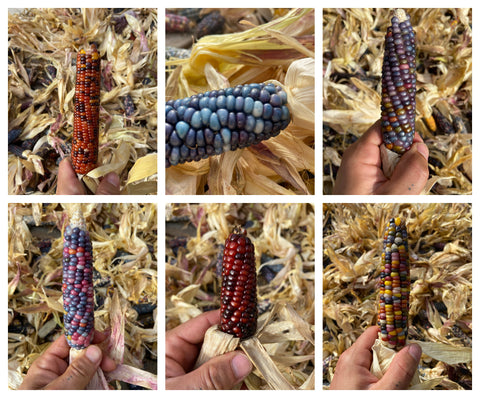
Types of Corn and How to Use Them
There are thousands of different varieties of corn, which can more or less be grouped into the following categories: Sweet, dent, flour, flint, and popcorn. The type of corn depends on the internal kernel structure and the amount of starch present. Sweet corn, for example, has the softest kernel, soft enough for humans to eat raw, whereas popcorn has the hardest kernels. As is usual in life, however, some corn exhibits characteristics of more than one of these categories, making corn characterization more a spectrum than mutually exclusive categories. Read on for more on each type of corn and its culinary uses!
Pictured: Sweet corn (click for seeds)
Sweet corn
Sweet corn varieties of corn are, well, charming! You can eat ‘em fresh off the cob if ya like. High in sugar, this is the corn most people are familiar with, that you can easily find at the grocery store. Actually, “sweet corn” is really just corn that is eaten when the kernels are immature (called the “milk” or “green” stage). There are many more delicious varieties of heirloom sweet corn that you’ve likely never tried before, like Painted Hill, or Soltera Morado! So, get experimental with your sweet corn.
Sweet corn uses:
-
Fresh off the cob: prepared as “sweet corn” or as Elote
-
Roasted: Roasted sweetcorn is called chicos and is dried, cooked corn on the cob
-
Pinole: a type of roasted corn flour
Dent corn
Dent corn is one level harder than sweet corn. You can easily distinguish dent corn from flint corn, which is of a similar hardness, by a tiny indentation in each kernel. Dent corn has low sugar and high starch content. Dent corn is harvested later in the season so that the dented kernels can dry out completely. It can then be processed into things that require “soft” starch, like chips and masa.
There is some traditional dent corn, but all of the corn you see growing in vast cornfields is junky, GMO hybrid dent corn. This GMO corn is used to make products like high fructose corn syrup and is fed to animals, which makes them sick. It’s a real shame that this incredible indigenous crop continues to be used for such terrible purposes. However, if non-GMO, heirloom varieties of dent corn are planted instead, they can be used for a variety of much healthier and more delicious products!
-
Chips: Masa is a corn flour used to make tortillas and tortilla chips
-
Bourbon: yes, you can also use corn to make moonshine!
-
Cornmeal: coarse flour ground from dried corn
-
Elote: a delicious grilled corn dish which is a popular street food in Mexico
-
Hominy: produced from dried kernels and used to make tortillas and tamales
Flour corn
Flour corn is made up mainly of soft starch, which means that it is ideally suited for making really fine cornmeal/corn flour. Flour corn is mainly dried and made into cornmeal. However, it can also be roasted, steamed, or barbecued at earlier stages.
-
Piki: a labor-intensive blue cornmeal originating from the Hopi tribe that is baked into very thin sheets
-
Atole: a sweet, hot corn beverage
-
Hominy: used to make tamales and tortillas
-
Posole: a light pork or chicken stew, made starchy with added cornmeal
-
Chicos: dried, cooked corn on the cob
-
Elote: grilled corn dish
-
Grits and polenta: made from flour corn, grit and polenta cornmeals are finer than when they are made from flint corn
Flint corn
The kernels of flint corn are mainly made up of a hard outer layer, which protect the small, soft endosperm inside. Varieties of flint corn often store well, as they are more resistant to rodents and insects because of their hardness.
-
Hominy: for tortilla masa or posole
-
Grits and polenta: these are essentially the same thing, but grits are made with white corn, and polenta is made with yellow
Pictured: Dakota Black Popcorn (click for seeds)
Popcorn
Everyone's favorite movie snack, popcorn, has the hardest of all types of corn kernels. The kernels will grow dry on the stalk, but are usually dried further after harvest to make for the best popping corn possible. Popcorn is made when the corn is heated. When the moisture in the middle of the kernel is heated, and enough pressure builds, the kernel “pops” and becomes that delicious treat that we all know and love! Try our favorite popping corn, Dakota Black.
-
Popcorn: movie style popped corn, seasoned with butter and salt - the obvious choice!
-
Hominy: using popcorn for tamales and tortillas is possible but requires nixtamalization, see below.
-
Cornmeal: popcorn can also be ground into coarse cornmeal to make things like grits, polenta, and atole nixtamalization.
What is Nixtamalization?
Nixtamalization is an ingenious process created by indigenous peoples to make corn more nutritious and edible in its “flour” form. It’s utilized to make the hominy used in tamales and tortillas and gives these corn products a unique, rich flavor.
Essentially, nixtamalization is the process of soaking and cooking corn in water that is mixed with some sort of alkaline solution (traditionally, wood ash is used; modern methods include using sodium hydroxide (“lye”), calcium hydroxide, pickled lime, etc.), and then hulled to remove the outer shell and soften the kernel. This process vastly improves the nutritional quality of the corn, as well as its digestibility, through a series of physical and chemical changes.
Sylvia of Pilar’s Tamales uses nixtamalized corn to make her tamales! See our Seeds of Our Ancestors article to learn more about Sylvia’s restaurant, her journey, and her ancestral foods.
Seed Saving Instructions
Corn is a difficult seed-saving crop, if you decide to save seeds, follow these tips:
- Corn suffers from inbreeding depression if seed is saved from too few plants, the minimum population size is 100 plants.
- Corn is cross-pollinated and will cross with all other corn varieties. It is wind-pollinated, which can carry pollen for several miles, so corn seed can be contaminated by GMO field corn. Isolate corn from other varieties by at least 2 miles.
- Harvest seed from the interior (as opposed to the outer rows) to help minimize crossing.
- Store seeds in a cool, dry area. See our How to Store Your Seeds resource for further instructions.

